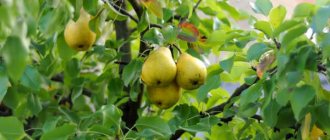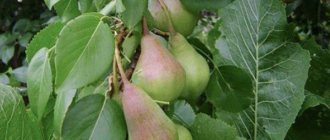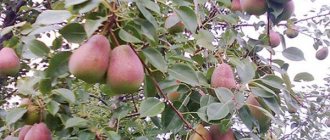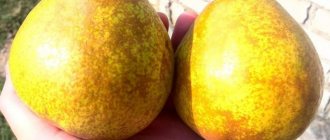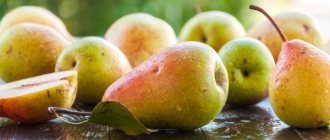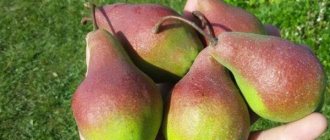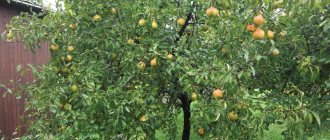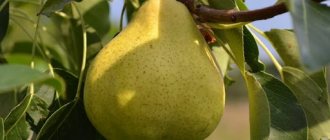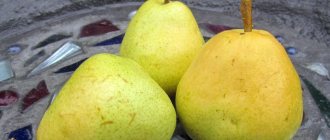Description of the variety
The description of the Kieffer pear variety is of great interest to gardeners, as it is becoming increasingly popular. Most summer residents are happy to diversify the list of fruit trees in their garden.
Kieffer's second name is Asian pear. The tree produces beautiful, tasty fruits that resemble apples in appearance. Also, the Asian pear has many names, for example, Japanese, Chinese. Some call it the Eastern Pear. This plant also has decorative value.
This is a fairly new species that has not yet spread among domestic summer residents and gardeners. Kieffer pear is mainly grown in Asian countries. It is worth noting that the presented pear has a significant difference from Jewish varieties. It is known for the special characteristics of the fruit, as well as its interesting appearance.
The fruit tree is beginning to gain popularity due to its positive characteristics. The pear of this type has good fruiting and a plentiful harvest. This is a fast-growing variety. Pears stay on the branches for a long time, which allows them to be collected in a whole, unbeaten form. Comparing, for example, the fruits of Kieffer and Duchess, you can see that they are very similar to each other. Gardeners appreciate the variety's good tolerance to heat and cold, resistance to disease, and undemandingness to soil.
Reviews from gardeners
Considering the description of the Kieffer pear, reviews from gardeners and summer residents, we can conclude that the variety is popular due to its ease of care, high yield, resistance to disease and other adverse effects. The fruits are known for their high taste. This is one of the best varieties for cultivation.
The variety is known and loved in the south due to its abundant yield and good health. In Russia, it can often be found in the Krasnodar region, Rostov region and Stavropol region. Kieffer is a kind of “lifesaver” of the southern garden; its productivity insures gardeners in unfavorable years against failures with more demanding varieties.
But in regions with harsh winters, it makes no sense to grow it. After all, the so-called “sand pears” with granulations in the fruits, to which the described form belongs, do not claim to be the elite of the garden.
The Kieffer pear was developed in the American state of Philadelphia in 1863. The variety was the result of crossing a wild pear and a cultivated variety, Williams or Anjou. The selection was carried out by the scientist Peter Kieffer, after whom the variety was named.
In 1947, the variety was imported and tested in the USSR. The Kieffer pear is recommended for planting in the North Caucasus, but it is grown in other regions. The variety is used by breeders to obtain new varieties of pear that are resistant to disease.
Kieffer has gained little distribution in Russia due to its temperature capriciousness, so there are few reviews about the variety. Those who have grown pears say that fruiting begins in the sixth year, and in the first years of cultivation it is really abundant. Pears do not degenerate over time, the fruits have a stable size and do not shrink.
The Kieffer's lifespan is about 30 years with proper care. The pear does not require replanting; it grows in one place all its life. It is worth taking a closer look at the variety if you plan to grow pears in a warm area. Kieffer is also worth planting if you already have experience in growing fruit crops, since the tree will not tolerate mistakes.
Productivity
Having planted a young tree on your site, you should know that you should expect productivity no earlier than five to six years. After this period, Kieffer will bear a bountiful harvest every year.
Reviews about the Kieffer pear variety are positive. The presented tree pleases gardeners with high, regular yields and early fruiting. On average, when a tree is 14-20 years old, you can harvest about 170-210 c/ha. For trees aged from 22 to 26 years, this figure reaches 262 c/ha. With an enhanced level of agrotechnical cultivation of the crop, an adult pear can bear fruits up to 305 kg. Kieffer produces a high yield almost every year.
What should a seedling be like?
- An unbranched seedling up to one year old should not exceed 120 cm in height. The girth of the trunk is 9-10 mm.
- The height of a branched seedling, one year old, should be 55-60 cm, trunk diameter 10-12 mm, branch length 50-100 mm.
- Two-year-old branched seedlings should have a length of 60-70 cm, a diameter of the stem part of 14-17 mm, and the length of the main branches up to 200 mm.
We invite you to familiarize yourself with: Characteristics of the late summer apple tree variety Yubilyar
When planting a three-year-old seedling, even the most experienced gardener cannot guarantee 100% survival rate.
When planting a seedling, it is necessary to take into account that for good pollination, another seedling of a different variety is needed.
- An unbranched seedling up to one year old should not exceed 120 cm in height. The girth of the trunk is 9-10 mm.
- The height of a branched seedling, one year old, should be 55-60 cm, trunk diameter 10-12 mm, branch length 50-100 mm.
- Two-year-old branched seedlings should have a length of 60-70 cm, a diameter of the stem part of 14-17 mm, and the length of the main branches up to 200 mm.
In order for the Kieffer seedling to take root better, you need to choose an annual seedling. It is advisable to immediately select a place for permanent planting; the tree will not tolerate transplantation well. The most important thing is that you purchase planting material from a specialized nursery. Because private companies or gardeners cannot guarantee good quality trees.
If you take a three-year-old seedling, it is not a fact that it will be able to take root.
Planting, care features
To properly plant a Kieffer pear seedling, you must adhere to the established rules. This will increase the likelihood that the plant will take root in the selected area. It is worth planting a tree of a different species nearby to ensure good pollination. In order for the seedling to be planted correctly, you initially need to prepare a hole with a diameter of 1 meter. Its depth must be at least 1 meter.
Then compost is poured into the hole; it is mixed with soil first. Before placing the plant in the hole, the seedling is dipped in a clay mixture. Then the root part should be placed in the center of the dug hole, and earth should be poured there. Next, straighten the roots. They are covered with soil. Then you should trample this piece of land, irrigating it abundantly with water. In order for the roots to receive a sufficient amount of moisture, you need to mulch.
The Kieffer pear tree needs some pruning. During the processing process, it is necessary to remove the conductors, and it is also worth cutting off the side shoots. This is necessary so that by the age of six a multi-tiered crown will form. This needs to be done gradually and every year.
Every five years it is necessary to feed the plant with potassium. As for nitrogen-type fertilizers, it should be fed with this composition in the spring before the flowering period begins. Watering should be done three times a season. You will need to pour about six buckets at a time into the root zone.
At the end of October, a small depression is dug near the tree. Water is poured into it. This is necessary for high-quality hydration of the root system. This procedure is repeated several times until cold weather sets in.
Also, to protect the fruit from wasps, it is worth soaking the plant in a solution containing salt. To prevent worms from appearing, the tree must be treated with Fufanon. For better growth of the pear in the warm season, you can feed it with a solution of manure and water. And in early autumn it is recommended to fertilize the soil with wood ash. And then the tree will delight you with the quantity of fruits and their taste.
Pear
Not everyone knows, much less has, the Kieffer pear in their garden. This variety is famous for its unusual taste, large and juicy fruits, as well as unpretentious care. For anyone who wants to discover a high-yielding variety that can grow on any soil, I will tell you in detail about it.
Description of the variety
Kieffer pear is a medium-sized variety with rapid growth. The tree has a fairly dense crown in the shape of a pyramid. The gray bark of the trunk becomes covered with cracks over time. Skeletal branches grow at an angle of 25-350 and are painted in dark gray tones.
Smooth shoots grow quite thick with pubescence in the upper part. The buds are small in size and grow in a sharp-conical shape. The leaves are large, ovoid in shape with jagged ends. In summer they have a rich green tint, and by autumn they turn purple. The platinum of the sheet is glossy and leathery.
Flowering of this variety begins early. The fruits are of average size (150-200 g), less often they grow to large sizes (350-400 g). As for the shape, the fruits can be either standard pear-shaped or barrel-shaped. The peel resembles a quince because it is thick, rough and lumpy.
During harvest, the fruits are colored light green, but in the process of full ripening they change to yellow, at the same time becoming covered with brown spots. The white flesh of the pear is juicy and crisp with a sweet-tart taste and a noticeable aftertaste.
Taste qualities
The fruits ripen by the second half of September. Moreover, ripe pears are held well on the branches and falling off is not typical for them. The fruits remain for another 2-3 weeks until they are fully ripe. Taste and presentation are preserved until the beginning of winter.
The pulp of the ripe fruit has a white tint with yellowness and a pleasant aroma. The taste of the pear is quite sweet with a slight tart taste. Juicy and crispy fruits can be consumed both fresh and canned.
Productivity
When planting a seedling, you should know that the first harvest can be obtained no earlier than in 5-6 years. Starting from this age, the young tree will annually delight with a large number of fruits. At the age of 15-17 years you can get 18-20 tons per hectare, and from 23 years this value will increase to 26 tons.
Advice! Proper care and compliance with certain agricultural practices will allow you to get up to 300 kg from one tree.
Features of care
One of the advantages of the Kieffer variety is its unpretentiousness. Moistening the soil for proper growth and development of the tree should be done 3 times during the summer: during the swelling of the buds, the growth of buds and the appearance of ovaries.
It is recommended to prune branches in the first 5 years to form the correct skeleton. In this case, the upper parts of the conductor must be removed to create several tiers. Bearing branches should be bent and fixed to artificially increase the growth angle. This procedure is necessary so that they do not break under the weight of a bountiful harvest.
Important! Dry and damaged branches must be pruned annually.
Fertilizers, like watering, are done three times per season:
- In the spring months, organic matter and nitrogen fertilizers are applied;
- In the second half of summer, potassium-phosphorus compounds are used;
- During the autumn digging of the soil, wood ash is added.
The Kieffer variety is quite resistant to diseases and pests, but you should not test this. To prevent infection before and after flowering, it is recommended to treat it with fungicides. When the fruits are fully formed, you should organize feeding with a saline solution, which will repel annoying wasps.
Since it is recommended to grow this variety in areas with a temperate climate, the tree will not require special shelter for the winter. It is enough to lightly dig up the area near the trunk, add mulch and cover the lower part of the trunk with spruce branches.
Pollination methods
The variety is self-pollinating, so fruits can be expected from the growth of one tree. However, experienced gardeners recommend planting other pollinating trees in close proximity to obtain a rich harvest.
Pears of one variety, Kieffer, are not the best option for cross-pollination; for this reason, other strains are planted.
Important! Organizing cross-pollination will increase the yield both on Kieffer and on the pollinator tree itself.
The best pollinating varieties are the following:
- Saint Germain;
- Conference;
- Bon Louise.
Advantages and disadvantages of the variety
Gardeners who grow Kieffer pears note the following advantages of the variety:
- Resistance to many viral and bacterial diseases, including fire blight;
- Easy to care for;
- Possibility of growing on different types of soil;
- Annually receiving a rich harvest;
- High taste qualities;
- Marketable condition;
- Good transportability;
- Drought tolerance.
Despite the large number of advantages, the variety also has disadvantages, which include poor frost resistance and an unusual aftertaste.
Ivan, 37 years old. Krasnodar
I have planted 5 trees of this variety on my site, and I don’t intend to stop there. From one tree you can get 150-200 kg of tasty and aromatic fruits, which sell like crazy on the market!
Svetlana, 45. Alushta
In the garden, in addition to the Kieffer pear, I grow several varieties of grapes, dogwoods and a lot of peaches. However, it is the pear that attracts the eyes of my guests. On the spreading branches, a huge number of large fruits ripen until the velvet season. Many vacationers like their unusual taste.
Alexander, 33 years old. Rostov
I have been professionally growing Kieffer pears for 7 years now. In the fifth year, I received my first harvest, which quickly sold out in stores. And since then, I have been receiving increasing amounts of these juicy fruits every year.
Source: https://sornyakov.net/frukty/grusha-kiffer.html
Resistance to pests and diseases
As experienced gardeners note, the Kieffer pear variety is little susceptible to various diseases. The tree and fruits are resistant to various bacteria and parasites. But it is still worth treating it for prevention.
This species can grow in hot and humid climates. The plant's unpretentiousness to soil conditions was noted. The Kieffer pear feels good and regularly bears fruit on various types of soil, including clay types.
The main advantages of the variety are:
- Good resistance to diseases and pests.
- It takes root on various soils.
- Very high yield in mature trees.
- The ability to remain without water for a long time.
It is thanks to all these advantages that the variety is gaining popularity. In our country they are starting to grow it almost everywhere.
Pollination rules
The description of the Kieffer pear makes it clear that this tree belongs to self-pollinating varieties. However, the plant can bear fruit even when grown alone. However, it is recommended to pollinate such a tree for high fruiting.
Therefore, it is advisable to plant another similar pear variety nearby. This method of pollination is called cross pollination. It can occur even at a fairly large distance. When planting another variety of pear, the yield on both trees increases significantly.
The pollination process itself is carried out in different ways. It depends on the region of residence, climatic influences and other factors. It is also worth considering that fruit trees of the same variety are the best source for pollen.
History of the cultivar
The Kieffer variety was obtained by Philadelphia breeders in 1863 on the basis of the seed of a sandy or Ussuri pear by pollination. One version says that pollination occurred with pollen from the Williams variety, and another version - from pollen from the Bere Anjou variety.
Kieffer pear is often called:
The originator Peter Kieffer gave his surname to the variety. The famous “Kieffer Seedling” was sent for state testing in 1947, after which it was assigned to zoning in the Krasnodar and Stavropol Territories, the Republic of Adygea and the Rostov Region. This pear variety is also grown in Georgia, Moldova, Ukraine and Central Asian countries.
The variety received its name in honor of the American breeder Peter Kieffer, who grew the seedling by sowing seeds of the Ussuri or sandy (Chinese) pear. The tree was randomly pollinated, presumably with pollen from Williams or Bere Anjou. Kieffer's seedlings were recognized as a new hybrid in 1863.
From Philadelphia, the seedlings came to Russia, where they immediately fell in love with gardeners from the southern regions. Since 1947, after testing, the cultivar was allowed to be grown in the North Caucasus region, but it is also found in Central Asia, Ukraine, Georgia, and Moldova.
Taste qualities
The full maturity of the Kieffer pear fruit is determined at the end of September. Ripe specimens are held very firmly on the branches. Thanks to this, they do not crumble. When laid down, they reach maturity in 15-20 days. The pear retains its taste until the beginning of December. The fruits can be transported without any difficulty.
A ripe pear has a pleasant white flesh with a slight yellow tint. The fruit is medium soft and has slightly hard granules near the core. The pear is crispy and very juicy. The pulp is characterized by high sweetness with a slight tart aftertaste.
Depending on the growing region, the chemical composition of the fruit includes dry soluble substances and a certain amount of sugar. The variety is ideal for fresh consumption, as well as for canning.
Hybrid fruits
Let's take a closer look at the description of the Kieffer variety.
The Kieffer pear is characterized by trees with a rapid growth rate. The seedlings form a medium-sized tree 3-5 m high with fissured gray bark on the trunk. The crown is pyramidal and prone to thickening.
Density is ensured by a large amount of foliage and shoot growth at an acute angle (30 degrees). Due to such a close location of the branches in relation to the conductor, constant monitoring of the condition of the crown is required.
The main branches that make up the skeleton are colored dark gray. Side shoots grow straight, are characterized by medium thickness, a smooth surface with a small edge on the tops. The annual growth is greenish-brown with a purplish tint. The pointed buds are pressed tightly to the branches. Fruiting on perennial wood, complex ringlets (fruits).
The variety is valued for its quality and decorativeness. The foliage is large, dark green in color with a dense glossy surface. The shape of the plate is oval with a pointed tip and a serrated edge, curved upward. The leaves sit on short burgundy petioles, and in the fall the tree dresses up in a crimson caftan. It blooms very early and requires additional pollinators. Saint Germain and Bon Louise are perfect for this role.
We suggest you read: What tree do walnuts grow on?
The turpentine flavor of fruit disappears during heat treatment.
It is rare for the fruits of the Kieffer Sapling to reach a large size. Most often they are of medium size in the range of 120−200 grams.
The shape of the fruit is oval or barrel-shaped. There are ribs and bulges on the surface of the pear, like quince fruits. The outer surface is rough and rusty, the pear skin is of medium thickness. Harvesting should be done when the fruit is light green in color. When they are fully ripe, the pears take on a golden yellow color with rusty spots spreading across them.
The pear pulp is juicy, granular, white, and may have a yellow tint. The density is medium, and in the center it is rough.
Harvesting occurs at the end of September, when the fruits are sent to rest, where they can ripen for another 3 weeks. While maintaining an attractive presentation and taste, pears can be stored until the beginning of winter.
